
Rena Guenduez, Team Leader of AMEP
Tell us about the Australia Mongolia Extractives Program (AMEP) and your role as Team and Technical Lead.
The Australia Mongolia Extractives Program is a donor funded program through the Government of Australia with the objective to support the Government of Mongolia to strengthen its extractive sector investment environment, through the development of collaborative partnerships between government, industry, and civil society. The program has been running for 9 years and has implemented some 54 activities providing institutional, policy and regulatory support, capacity development, and engaging with community and civil society as well as ensuring that gender inclusion and human rights are mainstreamed in the sector. The program aims to support a competitive, well governed, and responsible sector.
As the Team and Technical Lead for the Australia Mongolia Extractives Program, my role is multifaceted. It involves overseeing a range of activities aimed at enhancing Mongolia’s extractive industries.
This includes liaising with the Mongolian Government, managing our team, and ensuring the technical aspects of our projects are executed effectively. I see one of my most important roles as building partnerships and maintaining key relationships, through ongoing engagement while listening to diverse stakeholder interests to ensure that the program is strategically aligned with the demands of the sector and the governments strategic vision.
Could you tell us about AMEPs activity to improve the accessibility of Mongolia’s geoscientific data and how this program began.
I am very pleased to do so. The Mongolia Geoscience Catalogue or best referred to as MonGeoCat is a web-based system that allows anyone to search and access thousands of geological reports and maps related to Mongolia’s mineral resources. Since AMEPs implementation in 2015 it has been working in collaborative partnership with the Government of Mongolia to improve the availability, quality, and access of geoscientific data in Mongolia through some nineteen key direct and indirect activities implemented over a nine-year period to improve digitization in the sector.
Can you tell us what you did and some of the main challenges faced.
All the mining sector reports, such as annual reports, exploration reports, feasibility studies, and geological reports, were stored in hard copy in multiple offices across various government departments and agencies. This made it very difficult and time-consuming for anyone to find and use the relevant information, especially for foreign investors and prospectors who were interested in Mongolia’s mineral potential. In continued partnership with the Government of Mongolia and coordination with other multi-lateral donors, AMEP conducted a detailed needs assessment resulting in a rigorous design process, and a prototype build, considering the best practices and standards for digitization, automation, and database management. This saw IT hardware and software implemented and hard copy data and reports uploaded.
What are the main features and benefits of the MonGeoCat system, especially for potential investors and prospectors?
The MonGeoCat system has two interfaces. The first one is a WebGIS, which enables spatial searching with a web-based geographic information system. This is based on the ArcGIS platform, which is widely used for mapping and spatial analysis. The second interface is a metadata catalogue, which enables basic document searches. It is based on the GeoNetwork catalogue application, which manages spatially referenced resources. The system now contains 8,275 geological reports with 21,673 worldwide users. The system is available in both English and Mongolian and is accessible to anyone with an internet connection.
How has the MonGeoCat system impacted the mining sector in Mongolia?
The MonGeoCat system has significantly improved the accessibility and quality of Mongolia’s geoscientific data. It has increased the efficiency and effectiveness of the government agencies and departments that manage and regulate the mining sector. It has also enhanced the transparency and accountability of the mining industry, as all the reports and data are publicly available and verifiable. Most importantly, it has attracted more interest and investment from domestic and foreign investors and prospectors, who can now easily access and analyze the rich and diverse mineral resources of Mongolia. The Canadian Fraser Institute Survey has identified increased investor confidence as a result of the MonGeoCat and related digital systems. I should also note that in 2018 the MonGeoCat was evaluated and identified as the best geographical system at the international GeoSpatial World Conference held in India, which is a great honor and a reflection of the achievements of our collaborative partners.
I encourage interested readers to learn more or try out the MonGeoCat system, by visiting the website at webgis.mris.mn.
We understand that AMEP has also worked on other key activities which will interest investors, could you tell us about these activities?
AMEP has been instrumental in supporting the development of Mongolia’s first mineral valuation code, MONVAL. This initiative has standardized the valuation of mineral deposits in line with international standards, fostering collaboration between the Financial Regulatory Commission (FRC), government and investors. The MONVAL code will in its full implementation minimize disputes, support accurate valuations by mining companies, and ensure fair and transparent transactions. The establishment of the MONVAL Committee signals a professional commitment to the valuation standards, promising a bright future for Mongolia’s mining sector. This progress should certainly pique the interest of potential investors as this will further strengthen Mongolia’s investment environment.
It is our understanding that the AMEP program will be ending in March 2024, what does the future hold for Mongolia?
I believe that the AMEP program through its collaborative partnerships, sharing of knowledge, best practices, and lessons learned has been an important contributor to enhancing the investment environment. With the many initiatives undertaken through the programs life-cycle and the engagement of different stakeholders there is a promising new generation of leaders and stewards who will shape Mongolia’s extractive sector building on international best practices either adapting or adopting these into the Mongolian context to enhance transparency and good governance, ease of doing business and ensure the sector continues its path towards responsible mining in an era of energy transition.